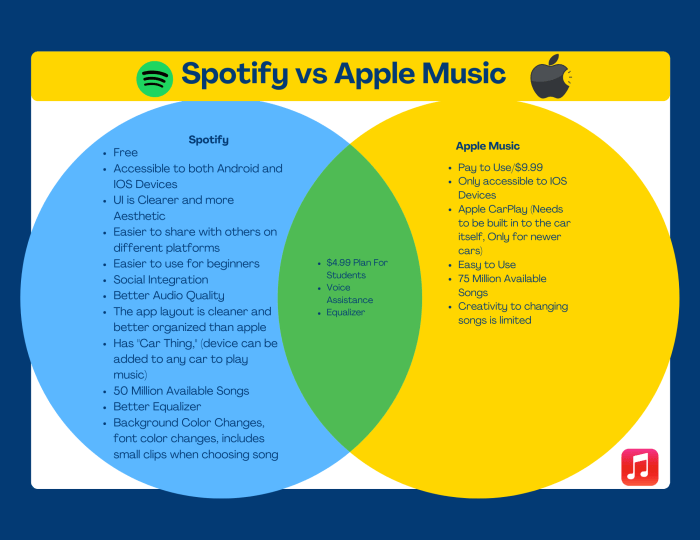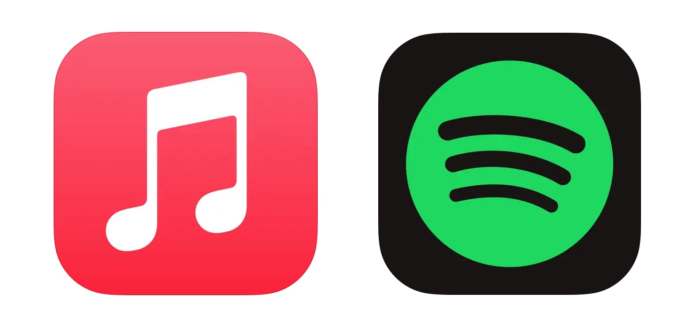Spotify vs Apple Music: A comprehensive comparison of these two titans of the music streaming world. This deep dive explores features, user experience, community aspects, integrations, mobile app performance, customer support, and even the historical context of each service. Prepare to be immersed in the intricacies of choosing the perfect platform for your music needs.
We’ll examine music libraries, pricing plans, audio quality, podcast and radio offerings, and more. The goal is to provide a well-rounded understanding of each service, helping you make an informed decision based on your individual preferences.
Comparing Features
Choosing between Spotify and Apple Music often comes down to personal preference and specific needs. Both platforms offer vast music libraries, sophisticated features, and a variety of subscription options. However, crucial differences exist in terms of pricing, available music, audio quality, and integrated services. Understanding these nuances is key to making an informed decision.
Music Streaming Plans and Pricing
Different subscription tiers influence access to features and benefits. Spotify and Apple Music offer various options catering to different budgets and usage patterns. Spotify’s tiered system typically includes a free option with limitations, followed by premium plans with ad-free listening and offline downloads. Apple Music also has a free tier with limitations, but its pricing model is generally structured around monthly subscription fees.
Pricing varies depending on the region and the specific plan selected.
Music Libraries and Genre Coverage
Both platforms boast extensive music libraries. However, their strengths lie in different genres. Spotify often excels in contemporary and popular music, while Apple Music may have a stronger presence in more established genres or niche artists. The available music can vary slightly depending on the user’s region.
Audio Quality and Playback Options
Both platforms prioritize high-quality audio. Spotify often uses a compressed format, but it’s sufficient for most users. Apple Music, depending on the tier, may offer higher audio quality options, enabling users to listen to music in a lossless format. Playback options like offline downloads and personalized playlists are commonly available across both platforms.
Podcasts, Playlists, and Radio Stations
Both platforms provide extensive podcast libraries, curated playlists, and radio stations. The specific selections and customization options may differ between the two services. Spotify often emphasizes personalized playlists based on user listening habits, while Apple Music’s curated playlists may have a more established or broad appeal. Each service’s approach to radio stations also varies in terms of genre selection and presentation.
Feature Comparison Table
| Feature | Spotify | Apple Music | Summary |
|---|---|---|---|
| Music Streaming Plans | Free (limited), Premium (ad-free, offline downloads) | Free (limited), Premium (ad-free, offline downloads, higher audio quality options) | Both offer tiered options; Apple Music often includes premium audio quality options |
| Music Library | Extensive, strong in contemporary music | Extensive, strong in established genres and niche artists | Both have vast libraries, but their focus areas differ. |
| Audio Quality | Compressed format, generally sufficient | Compressed format, higher quality options available | Apple Music offers lossless options for better quality. |
| Podcasts | Vast selection, strong personalization options | Vast selection, curated playlists available | Both platforms offer extensive podcast libraries with different approaches to content organization. |
| Playlists | Personalized and curated playlists | Curated and personalized playlists | Both platforms provide personalized playlists, but their approaches to curation may differ. |
| Radio Stations | Variety of curated stations | Variety of curated stations | Both platforms have radio stations; the exact genre selection and presentation may differ. |
User Experience and Interface
The user experience (UX) is a crucial factor in choosing a music streaming service. Beyond the music library, the ease of navigation, personalization, and overall interface design greatly impact user satisfaction. This section delves into the contrasting UX approaches of Spotify and Apple Music, examining their strengths and weaknesses in handling user preferences and customization options.Spotify and Apple Music both aim to provide intuitive experiences, but their methods differ significantly.
Spotify’s strength lies in its more open and adaptable interface, while Apple Music benefits from a tightly integrated ecosystem, often favoring simplicity over extreme customization. The key difference lies in the level of control users have over their experience.
Honestly, the Spotify vs. Apple Music debate is a never-ending one. But amidst all the streaming service squabbles, it’s good to see tech giants prioritizing security. For example, LastPass recently reassured users that no passwords were compromised in the latest security scare, lastpass says no passwords compromised in latest security scare. This reassures me that my digital life, including my music streaming subscriptions, might be a little safer.
Ultimately, the best streaming service still comes down to personal preference, but robust security is a key factor.
User Interface Design
Spotify’s interface is known for its clean, modern design and dynamic layout. The focus is on visual appeal and ease of use. The platform excels at showcasing diverse content through its visually engaging “Discover Weekly” and “Release Radar” features, effectively curating and highlighting new music. Apple Music, on the other hand, takes a more streamlined approach, focusing on a more familiar and intuitive experience for users already integrated into the Apple ecosystem.
Ease of Use and Navigation
Spotify’s navigation is generally considered more flexible and adaptable. Its extensive search functionality and personalized recommendations, such as “Your Daily Mix,” allow for deeper exploration. Apple Music’s interface, while straightforward, might feel slightly less adaptable to diverse user needs. Its curated playlists and radio stations are generally well-organized, but the sheer volume of options might feel overwhelming to some users.
User Preferences and Personalization
Both services offer extensive personalization options. Spotify allows for fine-grained control over preferences through the creation of customized playlists and the ability to filter recommendations. Apple Music prioritizes intuitive recommendations, tailored to the user’s listening history. Spotify’s strength lies in its more granular approach, empowering users to meticulously curate their experience.
User Profiles and Customization Options
Spotify allows for creating individual user profiles, facilitating distinct listening experiences for family members or friends sharing the same account. It also enables the creation of various playlists, allowing for focused listening sessions. Apple Music’s user profiles are less distinct, more closely tied to the overall Apple ecosystem. The customization options, while present, might feel less granular compared to Spotify.
Navigation Structure Overview
| Feature | Spotify | Apple Music |
|---|---|---|
| Homepage | Displays recently played tracks, trending content, and personalized recommendations | Focuses on curated playlists, trending artists, and radio stations |
| Search | Comprehensive search by artist, song, album, and playlist | Intuitive search functionality, with suggestions based on user’s listening history |
| Library | Organized by albums, artists, playlists, and podcasts | Organized by albums, artists, playlists, and podcasts |
| Discover | Features personalized recommendations and curated playlists | Highlights curated playlists and radio stations based on genre and mood |
| User Profile | Allows for personalized settings and separate accounts for family members | Less granular user customization options, tied more closely to the overall Apple ecosystem |
Community and Social Aspects: Spotify Vs Apple Music
Beyond the music itself, both Spotify and Apple Music offer extensive social features that significantly impact user engagement. These platforms aim to foster a sense of community, enabling users to connect with others who share similar musical tastes and discover new artists or genres. The strength and usability of these social aspects can greatly influence a platform’s popularity and long-term success.The social features on these music streaming services go beyond simply playing music together.
They provide avenues for users to interact with one another, fostering a sense of community and encouraging shared musical experiences. This interaction can range from sharing playlists to joining collaborative listening sessions, enhancing the overall user experience and making the platform more than just a place to listen to music.
User Interactions and Connections
The types of interactions users can have on these platforms are diverse. Users can follow artists, creating a direct line of communication. They can also connect with friends and family through shared playlists, creating a space for musical collaboration. Furthermore, collaborative playlists enable groups of users to contribute to a shared musical experience. This shared experience can lead to discovering new music, expanding musical horizons, and creating lasting connections.
New Music Discovery
Users can discover new music through various avenues on both platforms. Spotify’s Discover Weekly and Release Radar features are designed to curate personalized music recommendations. Apple Music’s curated playlists and editorial selections also aid in uncovering new artists and genres. These personalized recommendations can help users broaden their musical tastes and uncover hidden gems.
Honestly, the Spotify vs Apple Music debate is a bit of a tired one. But with Windows 10 previews of universal apps now available for PCs, tablets, and phones, it’s a whole different ballgame. Check out the latest updates on windows previews universal apps for windows 10 pcs tablets and phones for details. Ultimately, the choice between music streaming services still comes down to personal preference, but these new Windows features could impact the user experience for both, making it worth considering for the future of music streaming apps.
Sharing Music and Playlists, Spotify vs apple music
Sharing music and playlists is crucial for social interaction on these platforms. Users can easily share their playlists with friends and family on both platforms through various methods, like direct sharing links or social media integration. This aspect enables users to introduce others to their favorite music, fostering a sense of community and encouraging mutual musical exploration. Furthermore, shared listening sessions can create unique experiences, allowing users to engage in interactive musical discoveries.
Social Media Integration
Both Spotify and Apple Music integrate with various social media platforms. This allows users to share music, playlists, and listening activity with their social networks. The integration varies in functionality, affecting the scope and ease of sharing. Spotify’s broader integration with social media platforms may provide more opportunities for exposure and community building, whereas Apple Music’s focus on more direct sharing methods might cater to a slightly different social interaction pattern.
| Feature | Spotify | Apple Music |
|---|---|---|
| Social Media Sharing | Extensive integration with major social media platforms (Facebook, Twitter, Instagram). | Integration with social media platforms, but less pervasive than Spotify’s. |
| Collaborative Playlists | Allows for group collaboration on playlists, fostering a shared musical experience. | Supports collaborative playlists, facilitating a similar communal approach. |
| Friend Connections | Stronger emphasis on connecting with friends and family through shared playlists. | Provides methods for connecting with friends and family through shared listening. |
Integration with Other Services

Spotify and Apple Music offer robust integration with other services, enhancing their utility beyond just music streaming. This seamless integration is crucial for users who employ multiple platforms and apps in their daily routines. Understanding how these services connect with other apps and devices allows for a more holistic user experience.
Different Integration Methods
Spotify and Apple Music utilize various methods to integrate with other apps and devices. Direct connections allow for features like automatic playlist syncing across devices. Third-party integrations leverage APIs to facilitate seamless data exchange. For example, a user might connect their fitness tracker to Spotify to automatically play music based on their workout routines.
Honestly, the Spotify vs Apple Music debate is pretty tiresome. Ultimately, it boils down to personal preference, but lately, I’ve been more drawn to the user experience on Spotify. Meanwhile, Samsung’s latest Galaxy S24 is causing a stir, and some are claiming it’s like a pixel phone in many ways, and I am curious to know more. This comparison reminds me of the ongoing Spotify vs Apple Music war, where both are trying to be the best, but it’s all about the experience, isn’t it?
galaxy s24 is samsungs pixel I’m still leaning towards Spotify for now, but I’ll have to give Apple Music another try, to see if it’s finally worth it.
Cross-Platform Compatibility
Both platforms boast excellent cross-platform compatibility. Users can access their music libraries and playlists on various devices, including smartphones, tablets, computers, smart speakers, and even some smart TVs. The seamless transition between devices ensures a consistent user experience, regardless of the platform being used.
Third-Party Integrations
A wide range of third-party integrations are available for both Spotify and Apple Music. These integrations often enhance functionality and provide tailored experiences. For instance, users might use a specific fitness app to sync their workout playlists automatically to Spotify.
Playlist and Music Syncing
Both platforms excel at syncing playlists and music across different devices. Users can maintain a unified music library, ensuring their preferred music is accessible regardless of their location or device. The syncing capabilities enable a personalized music experience on all connected devices.
Integration with Other Apps
The following table Artikels examples of how Spotify and Apple Music integrate with other apps:
| Platform | Integration Type | Description |
|---|---|---|
| Spotify | Fitness App Integration | Spotify can sync workout playlists automatically with fitness apps like Peloton or Strava. This allows users to listen to tailored music based on their workout routine. |
| Spotify | Social Media Integration | Spotify allows users to share their listening history and playlists on various social media platforms, such as Twitter or Facebook. This feature fosters community and social interaction. |
| Spotify | Gaming Integration | Certain gaming platforms may integrate with Spotify to allow background music playback or curated playlists. |
| Apple Music | Fitness App Integration | Apple Music can integrate with fitness apps like Nike Training Club, providing music tailored to different workouts. |
| Apple Music | Home Automation Integration | Apple Music can integrate with smart home devices through Apple HomeKit, allowing users to control music playback from smart speakers or other compatible devices. |
| Apple Music | Podcast Integration | Apple Music allows seamless integration with Apple Podcasts, providing users with a unified platform for both music and podcasts. |
Mobile App Experience
The mobile apps for Spotify and Apple Music are crucial for accessing their services on the go. A seamless user experience is paramount for these platforms, and this section delves into the specifics of their mobile app performance, features, and usability. Understanding how these apps function on various devices is key to appreciating their overall value.
App Features and Functionalities
The functionality and features offered by each app’s mobile interface significantly impact user satisfaction. Spotify and Apple Music offer a range of functionalities, catering to diverse user needs.
- Spotify’s mobile app boasts a vast library of music, podcasts, and audiobooks. Its intuitive interface allows users to easily discover new content, create personalized playlists, and manage their subscriptions. The ability to seamlessly integrate with other services like social media platforms further enhances its appeal. The app is optimized for various devices, guaranteeing a consistent experience across different screen sizes.
The app offers multiple playback controls, including the ability to skip tracks, adjust volume, and control playback speed. Advanced features like offline listening and personalized recommendations are also part of the platform.
- Apple Music’s mobile app, designed for the iOS ecosystem, provides a curated selection of music, podcasts, and videos. Its interface is sleek and intuitive, with features that are often considered more visually appealing compared to Spotify. It offers a variety of playback controls, and offline listening is available. Features like family sharing and integration with Apple’s ecosystem (such as iCloud) are prominent aspects of the app.
Performance and Stability
The performance and stability of each app are critical factors influencing user experience. The responsiveness of the app and the frequency of crashes or glitches significantly impact overall satisfaction.
- Spotify’s mobile app generally performs well, providing smooth playback and quick access to features. However, reported instances of occasional glitches and stability issues exist, especially during peak usage periods. The app’s reliance on a large amount of data often results in varying performance based on network conditions.
- Apple Music, being deeply integrated with iOS, usually maintains consistent performance and stability. The app’s integration with the operating system often leads to a more seamless and responsive user experience, although it might not always be as flexible as Spotify in certain aspects. The integration with Apple’s ecosystem can contribute to occasional performance fluctuations, however, as it’s highly dependent on iOS’s performance.
User Experience for On-the-Go Listening
The ease of use and overall experience when listening to music on the go are crucial considerations. The app should be intuitive and responsive, providing a smooth experience for the user.
- Spotify’s on-the-go listening experience is well-regarded, particularly due to its vast catalog of music and podcasts, as well as its offline listening capabilities. The ability to create custom playlists and quickly navigate between tracks makes it very convenient for users on the move. Its simple design allows for effortless control of playback and browsing.
- Apple Music’s user experience for on-the-go listening is considered smooth and reliable, thanks to its intuitive interface. The app’s ability to easily access content and seamlessly transition between different music and podcast selections makes it a convenient option. Its integration with iOS features further improves its on-the-go usability.
Detailed Comparison of Mobile App Features
A table outlining the key features of both Spotify and Apple Music mobile apps.
| Platform | Feature | Description |
|---|---|---|
| Spotify | Offline Listening | Users can download music and podcasts for playback without an internet connection. |
| Spotify | Personalized Recommendations | The app uses algorithms to suggest music and podcasts tailored to user preferences. |
| Spotify | Podcast Library | Extensive library of podcasts, categorized and searchable. |
| Apple Music | Family Sharing | Allows multiple users to share a subscription and access the music library. |
| Apple Music | Integration with iOS | Seamless integration with other Apple services and features. |
| Apple Music | Lossless Audio | Offers high-quality audio streaming options, often including lossless formats. |
Customer Support and Help Resources
Navigating the digital landscape often requires assistance. Understanding the customer support systems of streaming services like Spotify and Apple Music is crucial for resolving issues and maximizing user experience. This section delves into the available channels and their effectiveness.Customer support is vital for any platform. Efficient and readily accessible support can significantly improve user satisfaction and retention.
This section compares the support options for Spotify and Apple Music, evaluating their help centers, FAQs, and contact methods.
Support Channels Comparison
Spotify and Apple Music offer diverse channels for user assistance, catering to different needs and preferences. Understanding these channels allows users to effectively seek help and resolve issues promptly.
- Spotify’s support resources are readily available through a comprehensive help center. This includes a vast library of articles addressing common issues like account management, playback problems, and payment concerns. The help center often includes troubleshooting steps and videos to aid in resolving technical problems.
- Apple Music’s support resources are similarly structured, with a dedicated help center. This center offers articles, FAQs, and tutorials on a wide array of topics, including account management, playback issues, and subscription management. Like Spotify, Apple Music’s help center often includes video tutorials to illustrate solutions.
Contacting Support
Both platforms provide various methods for contacting support teams. Choosing the appropriate method can streamline the resolution process.
- Spotify offers support via phone, email, and a dedicated in-app help center. Users can find solutions to their problems through these channels, ensuring assistance from a qualified support agent when needed. The in-app help center allows users to quickly navigate to relevant information. For complex issues, phone or email are ideal.
- Apple Music also offers phone, email, and online help. The help center provides a broad range of articles addressing diverse queries. Users can access articles for common issues, enabling self-service solutions. If users need personal assistance, phone or email options are available.
Issue Resolution Methods
Different methods of issue resolution cater to different needs and complexity levels.
- Spotify prioritizes self-service solutions through its extensive help center. This approach allows users to resolve many issues independently, saving time and resources. If users need support, they can escalate to phone or email contact, ensuring prompt assistance from qualified agents.
- Apple Music’s support channels function similarly, offering self-service solutions through its help center. The system facilitates user-driven issue resolution and reduces wait times for phone or email support. This dual approach balances ease of use with personal assistance for more complex issues.
Summary Table
This table summarizes the various support channels for each platform.
| Feature | Spotify | Apple Music |
|---|---|---|
| Help Center | Extensive, with articles and videos | Comprehensive, with articles and videos |
| Phone Support | Available | Available |
| Email Support | Available | Available |
| In-app Help | Integrated | Integrated |
Historical Context and Evolution
The music streaming landscape has been dramatically reshaped by Spotify and Apple Music. Their journey from nascent services to global behemoths is a fascinating study in innovation and adaptation. Both platforms have navigated evolving user expectations, technological advancements, and competitive pressures to achieve their current positions. This section delves into the historical context, milestones, and major changes that have shaped their development.Spotify, launched in 2008, emerged in a world of burgeoning online music consumption.
Apple Music, entering the scene in 2015, faced an already established competitor with a considerable user base. The evolution of both services reflects the dynamic nature of the digital music industry.
Spotify’s Evolution
Spotify’s early years were characterized by a freemium model, offering a limited selection of music for free with the option to upgrade to a premium subscription. This strategy proved highly successful in attracting a large user base. Key milestones include the introduction of the “Discover Weekly” playlist, a groundbreaking feature that personalized music recommendations for users. The platform’s expansion into podcasts further broadened its appeal.
Over time, Spotify’s approach shifted to emphasize podcasting, live audio, and other audio-related content, reflecting a diversification of its offerings. This evolution is directly linked to evolving user preferences and the growth of the podcasting market.
Apple Music’s Development
Apple Music’s trajectory focused on integration with existing Apple ecosystem products. Early features prioritized seamless connection with iOS devices, offering an integrated experience that appealed to Apple’s loyal user base. The service’s development emphasized high-quality audio streaming, with features like lossless audio downloads aimed at discerning music enthusiasts. The introduction of curated playlists and radio stations complemented the service’s core offering.
Apple Music’s growth has been tied to its integration into the broader Apple ecosystem, reinforcing its core positioning as a music and entertainment hub.
Key Milestones and Innovations
- Spotify: The launch of the “Discover Weekly” playlist in 2015 significantly altered the user experience by personalizing music recommendations. This feature, alongside its freemium model, was pivotal in attracting and retaining users.
- Apple Music: The integration with the Apple ecosystem was a crucial element in Apple Music’s strategy. This seamless integration across devices and services contributed to the initial adoption rate.
- Both: The evolution of both services demonstrated a crucial understanding of the importance of diverse content offerings. The addition of podcasts and other audio content expanded their reach beyond traditional music streaming.
Major Changes and Updates
- Spotify: Spotify’s expansion into podcasts and live audio demonstrates a strategic shift toward diversified audio content. They also introduced features like “Car Thing” and “Spotify Wrapped,” which provide more personalized and interactive experiences for users.
- Apple Music: Apple Music’s introduction of high-quality audio streaming, including lossless and spatial audio, showcases its commitment to premium audio quality. These enhancements were in response to user demand for superior audio experiences.
Impact on User Experience and Market Positioning
The innovations and changes implemented by both platforms significantly impacted user experience and market positioning. The personalized recommendations on Spotify, for example, enhanced user engagement and discovery. Apple Music’s integration with the Apple ecosystem solidified its appeal to a pre-existing user base. Both platforms demonstrated a clear understanding of the evolving preferences of music consumers.
Timeline of Key Events and Updates
| Year | Platform | Event/Update |
|---|---|---|
| 2008 | Spotify | Launch of Spotify |
| 2015 | Spotify | “Discover Weekly” playlist introduced |
| 2015 | Apple Music | Launch of Apple Music |
| 2020 | Spotify | Significant expansion into podcasts and live audio |
| 2022 | Apple Music | Introduction of spatial audio |
Final Thoughts

Ultimately, the best music streaming service depends on individual priorities. Spotify’s vast library and social features might appeal to those who value community and discovering new artists, while Apple Music’s tighter integration with Apple ecosystem might be preferable for users already heavily invested in that world. This comparison offers a clear picture of the strengths and weaknesses of each, allowing you to confidently select the platform that aligns best with your needs.






